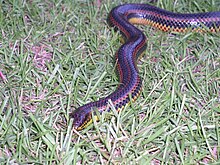
Agkistrodon piscivorus is a species of pit viper in the subfamily Crotalinae of the family Viperidae. It is one of the world's few semiaquatic vipers, and is native to the southeastern United States. As an adult, it is large and capable of delivering a painful and potentially fatal bite. When threatened, it may respond by coiling its body and displaying its fangs. Individuals may bite when feeling threatened or being handled in any way. It tends to be found in or near water, particularly in slow-moving and shallow lakes, streams, and marshes. It is a capable swimmer and, like several species of snakes, is known to occasionally enter bays and estuaries and swim between barrier islands and the mainland.
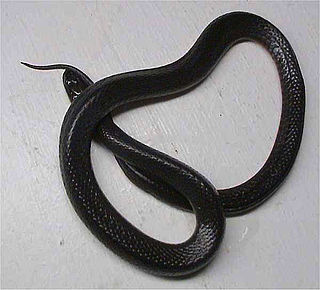
The black swamp snake is a species of snake in the subfamily Natricinae of the family Colubridae. The species is endemic to the southeastern United States. There are three subspecies, including the nominotypical subspecies.

Nerodia is a genus of nonvenomous colubrid snakes commonly referred to as water snakes due to their aquatic behavior. The genus includes nine species, all native to North America.

Cemophora coccinea, commonly known as the scarlet snake, is a species of nonvenomous snake in the family Colubridae. The species is native to the southeastern United States. There are two subspecies of C. coccinea that are recognized as being valid. The Texas scarlet snake was previously considered a subspecies.

Nerodia rhombifer, commonly known as the diamondback water snake, is a species of nonvenomous natricine colubrid endemic to the central United States and northern Mexico. There are three recognized subspecies of N. rhombifer, including the nominotypical subspecies.

The Florida cottonmouth is a species of venomous snake, a pitviper in the subfamily Crotalinae of the family Viperidae. The species is endemic to the United States, where it occurs in southern Georgia and the Florida peninsula in nearly every type of wetlands in the region, including brackish water and offshore islands. However, it is not entirely dependent on water and is occasionally encountered as far as a mile from surface water. Agkistrodon conanti venom is very hemolytic and known to cause relatively extensive necrosis compared to many snake venoms, and can sometimes be lethal with a 17% mortality rate. It is often confused with harmless watersnakes (Nerodia) and other semi-aquatic species with which it shares its habitat.

Cemophora coccinea copei, commonly known as the northern scarlet snake, is a subspecies of harmless colubrid snake that is native to the southern and eastern United States.

The smooth earth snake is a species of nonvenomous natricine colubrid snake native to the eastern half of the United States.
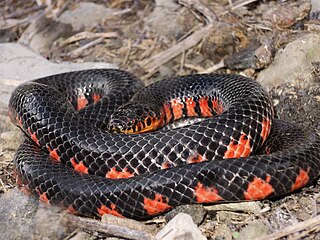
The mud snake is a species of nonvenomous, semiaquatic, colubrid snake endemic to the southeastern United States.

Pituophis melanoleucus, commonly known as the pine snake, is a species of nonvenomous snake in the family Colubridae. The species is endemic to the southeastern United States. Three subspecies are currently recognized as being valid.

Agkistrodon contortrix mokasen was formerly a venomous pit viper subspecies found in the eastern United States. However, recent taxonomic changes do not recognize the northern copperhead as a valid taxon.

The crayfish snake, also known commonly as the glossy crayfish snake, the glossy swampsnake, the glossy water snake, and the striped water snake, is a species of semiaquatic snake in the subfamily Natricinae of the family Colubridae. The species is endemic to the southeastern United States, and preys mainly on crayfish.

Heterodon simus, commonly known as the southern hog-nosed snake, is a harmless snake species endemic to the southeastern United States. No subspecies are currently recognized.
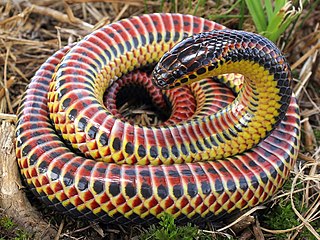
Farancia erytrogramma is a species of large, nonvenomous, highly aquatic, colubrid snake, which is endemic to coastal plains of the southeastern United States. Two subspecies are recognized as being valid, one of which has been declared extinct.
Wilfred T. Neill (1922–2001) was an American herpetologist and author. His name survives in the scientific names of the central Florida crowned snake, Tantilla relicta neilli, and a Central American snail-eating snake, Sibon sanniolus neilli.
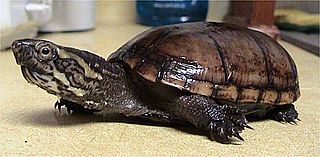
The eastern mud turtle or common mud turtle is a common species of turtle in the family Kinosternidae. The species is endemic to the United States. There are two recognized subspecies.
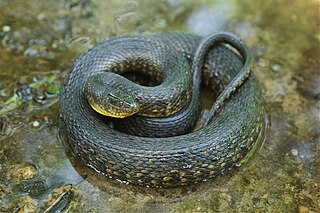
The green water snake is a common species of nonvenomous natricine snake endemic to the southeastern United States.

The brown water snake is a large species of nonvenomous natricine snake endemic to the southeastern United States. This snake is often one of the most abundant species of snakes found in rivers and streams of the southeastern United States, yet many aspects of its natural history is poorly known. Due to abundance and distribution throughout its biological range, this species could be used to investigate anthropogenic impacts on aquatic ecosystems by studying their movements.
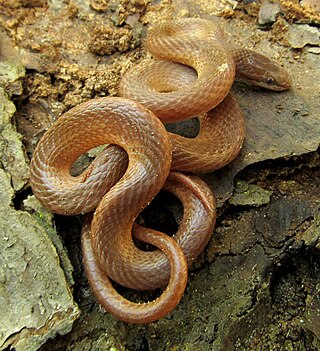
The pine woods snake, also commonly known as the yellow-lipped snake or the brown-headed snake, is a species of secretive colubrid found in scattered locations across the south-eastern United States. Rhadinaea flavilata is rear-fanged and mildly-venomous, but not dangerous to humans.
